Max Allan Collins's Blog, page 46
June 6, 2017
A Cancellation, a Nomination & an Anniversary
HBO/Cinemax has finally officially cancelled the Quarry series, but this comes as no surprise. A shake-up at the network, as well as a conflict between the star (who is committed to another series pilot) and the director of all eight episodes, spelled it out long ago.
What’s most disappointing to me is that my script for season two will not be produced, and I was really happy with it. We had thought some other network might pick the show up, but that now seems unlikely.
I am happy to have had a quality show that gave my Quarry books a higher profile. My hitman has now generated an award-winning short film, a festival-winning feature, and now a first-rate series, and my writing was a part of all three. Maybe we’ll see more of him on screen yet.
More pleasant news came by way of a Shamus nomination for the Spillane/Collins short story, “A Dangerous Cat,” which appeared in The Strand magazine and is also in the collection A Long Time Dead: A Mike Hammer Casebook from Mysterious Press.

Barb and Al, early 1970s
But the biggest event of the past week was our 49th wedding anniversary, on June 1, which we celebrated with an overnight stay at Galena, Illinois, where always have a wonderful time. For me, it was especially gratifying because – after the various operations and the stroke and all – I was able to spend a long day walking and enjoying myself, feeling very much back to normal (or as close to normal as I ever get). Galena is a quaint, pretty little town of 3500, with lots of boutique shopping and some 65 restaurants. I will be doing a thriller next year set in this scenic community.
On the trip to and from Galena, we finished listening to the audio book of Antiques Frame, so beautifully read by Amy McFadden. It was a reminder to me about how much Barb has grown and flourished as a writer, a profession she never dreamed of entering. Having such a beautiful, talented, smart, funny, patient wife for all these years is the best award/reward I could ever hope for.
The week leading up to the two-way getaway was a busy one, as was the weekend following. I did final edits on the Spillane volume, The Last Stand, which includes the previously unpublished novel of that name, as well as an early ‘50s novella, also previously unpublished, A Bullet for Satisfaction. The latter is a Spillane/Collins collaboration, the former the last solo effort by Mickey. There’s also an introduction explaining the history of both novels. Hard Case Crime will be publishing in both hardcover and soft.
In addition, I wrote the introduction for the collected Dick Tracy Volume 23, for IDW, and dealt with the copy-edited versions of two short stories written by Matt Clemens and me for a pair of horror anthologies. Finally, I wrote the introduction to Scarface & the Untouchable, the joint Capone/Ness bio.
That book now focuses on the Chicago years, with a second volume projected to deal with the rest of Ness’s life. This week I’ll start work on my polish/tweak of the nearly 900-page manuscript. Co-author A. Brad Schwartz and our writing/research associate, George Hagenauer, are working on the bibliography and end notes.
* * *
The complete list of Shamus nominations can be seen at the great site, The Rap Sheet.
Here’s a good current interview with me.
A ton of articles on the cancellation of the QUARRY series are out there, many quoting Michael D. Fuller’s blog post about it. Here’s a good example.
M.A.C.
May 30, 2017
Antiques on Audio
Our previous update was largely about audio versions of M.A.C. titles, particularly how great a job Dan John Miller does on Nate Heller and will soon be doing for Mike Hammer, now that Stacy Keach has stepped down.
Last year, for the first time, one of our Trash ‘n’ Treasures mysteries under the joint “Barbara Allan” byline was released on audio – Antiques Fate. It was a professional job, and Barb and I were happy to have it out there, but we felt our protagonists – Brandy and Vivian Borne – needed to be more distinctly different in performance. We also felt the audio had given our book a typical cheery cozy mystery feel, whereas the Antiques books are rather subversive send-ups of the genre, with Brandy a put-upon, wry narrator, and Vivian an off-the-wall local theatrical diva. We made our feelings known, and the publisher responded by assigning the very talented, skillful Amy McFadden to the just-released-on-audio, Antiques Frame.

Amy McFadden
We are about half-way through the audio, and are delighted with what Amy is doing. She has captured both our main characters, and their narrative voices (we have first-person narration from both Brandy and Mother) beautifully. As her web site notes, “Amy McFadden has narrated over 250 titles in many different genres with a focus on Comedic Fiction, Romance, and not-super-violent Thrillers. She is an Earphones Award winner, and a four-time Audie Award finalist in Humor, Mystery/Thriller and Literary Fiction.”
Read more about her here.
Speaking of the Antiques series, we recently completed Antiques Wanted. I interrupted work on the Eliot Ness/Al Capone joint bio to work on it, when Barb delivered me her rough draft. I also have been working on a Spillane book for next year’s centenary of his birth, completing an early ‘50s novella, A Bullet for Satisfaction, and editing his last solo novel, The Last Stand, for joint publication by Hard Case Crime. Should be a very special book – Mickey finished The Last Stand a few weeks before he passed.
* * *
Gregg Allman died at home last week at age 69.
I admit to not being an enthusiast of Southern Rock, but Allman’s talent is inescapable. I did not know him, but we intersect in an interesting way.
In 1967, as some of you know, my band the Daybreakers went to Nashville to record. My father had been a high school music teacher and one of his students became a successful country western artist – Jack Barlow. Barlow’s producer was Buddy Killen, the top music publisher in Nashville – his Tree Music was where Ms. Tree’s name came from, by the way. Killen, a very nice, sophisticated man, was also a major Nashville producer. He agreed, as a favor to Barlow, to record and produce a session with the Daybreakers. We figured we’d go home with something professional to release locally.
Killen had some top country artists on his roster, including Barlow. But he also had a major r & b artist, Joe Tex, who was released by Atlantic’s subsidiary, Dial. The Atlantic execs had told Killen he needed to round out his roster with a rock act, so he was on the lookout. After our session, he signed us to five-year contracts and, in early ‘68, “Psychedelic Siren” was released. It became a regional hit, and has since become oddly famous, covered any number of times by other groups, and included on various compilations of Sixties garage band rock. To some, it is my major claim to fame.
But back in 1967, times changed in a short time span, with our Paul Revere & the Raiders/Turtles approach dating almost immediately – we heard “Purple Haze” and “Light My Fire” on the radio, driving back to Iowa, and exchanged a collective, “Uh oh.” We learned those two songs at our next practice.
Where does Gregg Allman come in?
Well, Killen signed one other rock act – a group called, at the time, the Allman Joys.
“They were really way ahead of their times, I realize now,” Killen said, talking about the Allman Brothers, not the Daybreakers.
Our one Dial single was DIAL #45-4066. The Allman Joys’ “Spoonful” was DIAL #45-4046. A recent E-bay auction brought $89 for the Allman Joys single. But “Psychedelic Siren” went for $199.99.
Either way, Killen dropped us both.
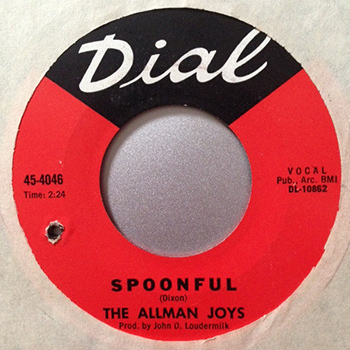
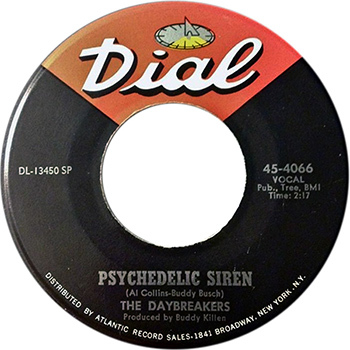
* * *
Here’s a nice article on why the Road to Perdition film is an overlooked masterpiece (they left out that I created the story, though).
M.A.C.
May 23, 2017
“The Will to Kill” Coming to Audio
This is one of those Good News/Bad News situations, only it’s really Good News/Bad News/Good News.

Stacy Keach
Many Mike Hammer fans – myself included – were dismayed when Blackstone Audio ceased releasing the new Hammer novels on audio, performed by the great Stacy Keach, starting with the current Will to Kill.
All of the previous Spillane/Collins “Hammer” collaborations, read by Stacy, remain available on Audible and elsewhere – they include The Goliath Bone, The Big Bang, Kiss Her Goodbye, Lady, Go Die!, Complex 90, King of the Weeds, Kill Me, Darling, and Murder Never Knocks. In addition are the two Audie-honored radio-style, full-cast audios, The New Adventures of Mike Hammer Vol. 2: The Little Death and The New Adventures of Mike Hammer Vol. 3: Encore for Murder. (There’s also a volume one that Stacy appears in but I did not write, more keyed to the ‘80s TV show than the novels).
Now a new audio publisher, JournalStone, has stepped in, with The Will to Kill first on the docket. Efforts to secure the rights to the short story collection, A Long Time Dead, are under way (I don’t personally hold those). That’s the very good news.
But the bad news is that Stacy Keach is stepping down.
Having ten works of mine (and Mickey’s) with the participation of perhaps the most famous screen Mike Hammer has been a privilege and a gift. I can’t convey what a thrill it’s been hearing Stacy’s voice roll out of those speakers, playing Hammer in stories I co-wrote. I remain thrilled and grateful to Stacy, and he and I will continue to explore projects (both Spillane and otherwise) to do together.
In the meantime, JournalStone has accepted my suggestion for a new audio Mike Hammer in the form of Dan John Miller.

Dan John Miller and his very Velda-like wife
Tracee Mae Miller
Dan is singer-songwriter and actor from Detroit, currently guitarist and lead vocalist for the gothic country-garage band, Blanche, which also features his lovely wife, Tracee Mae Miller. He has appeared in a number of films, notably Walk The Line, playing Johnny Cash’s guitar player Luther Perkins. Among his many outstanding musical accomplishments, Dan collaborated with Jack White in the band Two Star Tabernacle. (He is also a man of great musical taste, once calling Crusin’s “First Step” on the Bullets CD “the perfect rock ‘n’ roll song.”)
For our purposes, however, it’s his work as one of the top audiobook narrators in the field that is most pertinent.
Dan was named a Best Voice by AudioFile magazine for performances of Pat Conroy’s The Lords of Discipline and Philip Roth’s My Life As a Man. In 2009, he was nominated for two Audies, as well garnering an Audiofile magazine Golden Earphone award, and a Listen Up! award from Publishers Weekly.
Even more important, for anyone likely to be looking at this update, is that Dan John Miller has been the voice of Nate Heller for several years now. He has recorded every Heller novel to date, from True Detective to Better Dead, as well as the short story collection (Chicago Lightning) and novella omnibus (Triple Play). He has done an outstanding job and – much as I’ve looked forward to hearing Stacy as Hammer – the new Heller novels of recent years have only seemed “real” to me after Dan has brought them to life.
At my urging, other audio publishers have tapped on Dan’s shoulder for the Mallory series, entries in the Disaster series, a Quarry (The Wrong Quarry), and the Reeder and Rogers series, currently Executive Order. He brings tough characters to life with both an edge and warmth, and I am very fortunate to have him agree to pick up where Stacy left off with Mike Hammer.
No release dates yet. In fact, I may be a trifle premature here, because some of the negotiations remain under way. But everything looks good – and will sound good.
If you’re a fan of my work, I couldn’t recommend Stacy and Dan – and their respective contributions to the Collins canon – to you more highly. The JournalStone releases will be available on CD, and as downloads from Audible.
Stay tuned.
* * *
Appropriately, Ron Fortier has posted a nice review of The Will to Kill.
Here is a rather unflattering review of the same Mike Hammer book. I generally do not respond to critics, but I have asked my grandson Sam to reply for me. You will see his reply below the link to the review.
Finally, here’s a positive review of The Wrong Quarry, one of my favorite books in the series.
M.A.C.
May 16, 2017
Still Crazy About “Gun Crazy”
People are always asking me what I read.
It’s one of the most common questions a writer gets, and I guess I understand it – apparently comes from a desire by a reader to get recommendations from someone whose work they like, and/or validation for books they like from that writer.
I disappoint people when I reveal how little I read of contemporary crime fiction. I’ve stated my reasons many times, but one reason I haven’t discussed much is the busman’s holiday aspect – not that, at the end of working day immersed in crime and mystery, I want nothing more to do with my genre of choice. Rather, that the writing process has worn out the same muscles that are used for reading.
So come evening, Barb and I watch plenty of crime and mystery TV and movies, although admittedly the movies tend to be older ones (like the books in the genre that I do read) and the TV tends to be British. I have a PAL friendly DVD player, and a Region B friendly Blu-ray player, letting me order discs from the UK all the time. We just watched the third season of Broadchurch, for example, and liked it very much. We also watched an excellent British series called The Forgotten, about very old, very cold cases. Also the fourth season of Endeavor and the third season of The Fall. We are looking forward (I’ve already ordered them) to seasons of Midsomer Murders, Murdoch Mysteries, the first season of Tennison, and the last season of Ripper Street.
So I’m very much still interested in the genre, although much of the American brand of TV mystery leaves me lukewarm to cold.
And much of my “reading” of mystery fiction these days is listening to audio books in the car. We have six-hour drives to St. Louis to see son Nate and his bride and our grandson, fairly frequently, and our day trips run to Chicago (four hours one-way) and Des Moines (three hours one-way). We listen to my own stuff – right now, Dan John Miller is doing a great job on Executive Order – and are happy to have Antiques Frame on audio to listen to next. We re-listen to Rex Stout novels and novellas for the umpteenth time, have been through all of Christie, and quite a few Simenon “Maigrets” (after watching the complete French/Belgian series starring Bruno Cremer – loved it).
What I do read, and it tends to be late at night, is a certain amount of non-fiction. Currently I’m reading Brian De Palma’s Split-Screen: A Life in Film by Douglas Keesey, and enjoying it. But I want to recommend a book that you have to go to some trouble to lay hands on.
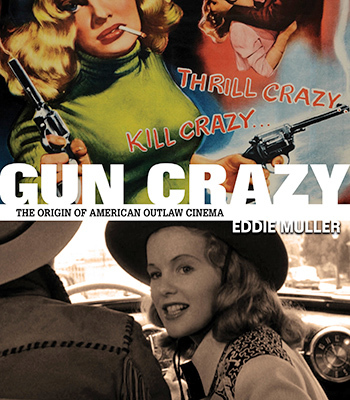
Gun Crazy: The Origin of American Outlaw Cinema by Eddie Muller is available only here:
http://blackpoolproductions.com/guncrazyretail.html
No Amazon. I stumbled onto a bookstore that carries it (Mysterious Bookshop in NYC). It’s the first American edition of a French book that was available with a wonderful elaborate Blu-ray edition of Gun Crazy.
Muller should need no introduction – he’s the undeniable guru of film noir, the man behind the Noir City Festival and the Noir City Foundation, with its wonderful e-mail magazine and yearly annual. Not surprisingly info is available at www.noircity.com. He’s written acclaimed fiction and non-fiction in the noir vein, and he appears regularly on TCM, every Sunday morning, your time much better spent than watching the Sunday political shows or going to church.
His book on Gun Crazy is remarkable – it’s like reading a terrific Gold Medal paperback that happens to be true, digging into all of the history from my fellow Iowa author MacKinley Kantor to blacklisted screenwriter Dalton Trumbo, from the maniac King brothers to my favorite B-movie director, Joseph H. Lewis. The pictures are so great – photos, documents, script pages – that the book worked beautifully in French, which I can neither read nor speak. In English it’s sheer delight. Muller contends the auteur theory is crap, an opinion with which I don’t entirely agree, but he makes an excellent argument, using Gun Crazy – so often credited to Lewis more or less exclusively – as a case in point.
My history with Gun Crazy goes back to 1967. I saw Bonnie and Clyde before the fuss, and my life was changed – the fusion of true crime and the fiction genre I loved was taken to a whole new level. I was so in the thrall of Bonnie and Clyde that I read everything I could get my hands on about the real outlaw couple, even looking at old newspapers on microfilm (setting the stage for Nathan Heller research), and I set out to see every movie derived from their story.
That was no easy task in 1967. VCRs were almost a decade away, so I was left to the whim of late-night movies and a University of Iowa film series at the student union, where mostly kids came to laugh at old movies that they were so much smarter than. One by one I picked the movies off: The Bonnie Parker Story (1958), cheapjack sleaze (which is okay by me, generally); They Live by Night (1948), terrific movie directed by Nicholas Ray; You Only Live Once (1937), a Fritz Lang-directed film and another good one; and finally Gun Crazy (1950). As a kid, I’d seen a Naked City episode called “A Case Study of Two Savages” that had frightened and excited me, but had no idea Rip Torn and Tuesday Weld were doing Clyde and Bonnie. I caught up with it again a year or so ago and saw the connection, and wondered if it had inspired in any way the Arthur Penn 1967 Bonnie and Clyde.
It’s surprising that the outlaw couple had already generated very good Fritz Lang and Nick Ray movies (also not surprising that a cheapjack Roger Corman-produced film existed, as part of the drive-in movie cash-in on The Untouchables TV show). But what was astonishing about Gun Crazy (in addition to a thousand other things) was that it was better than Bonnie and Clyde. That after having my life changed by Bonnie and Clyde, Gun Crazy changed it all over again, more deeply, and became a movie on my very, very short list of favorites (regular readers here may recall the others: Vertigo, Kiss Me Deadly, Phantom of the Paradise). It’s a love story in the way the best James M. Cain novels are, and that’s high praise.
Eddie Muller’s book on Gun Crazy is so terrific, so entertaining, I had a reaction that I rarely have: Oh, good – I don’t have to write this book…somebody else has done it for me.
* * *
A local paper has published a nice little article about my Grand Master “Edgar” honor, here (look past the misspelled first name, will you?).
And here is Ellery Queen Mystery Magazine’s editor’s blog on the Edgar event, with a nice shout-out to me.
M.A.C.
May 9, 2017
“Please Sir, I Want Some More…”
The International Association of Media Tie-In Writers has announced the Scribe Award Nominees for 2017, and I pleased to have three nominations.
Acknowledging excellence in the tie-in field, the IAMTW’s Scribe Awards honor licensed works that tie in with other media such as television, movies, gaming, or comic books. They include original works set in established universes, and adaptations of stories that have appeared in other formats and that cross all genres. Tie-in works run the gamut from westerns to mysteries to procedurals, from science fiction to fantasy to horror, from action and adventure to superheroes.
The Scribe Award winners will be announced at ComicCon San Diego in July. The exact day, time and location of the Scribes Panel including the award ceremony will be announced once it’s known. I am weighing whether or not I’ll be attending this year – if I am, I will host the panel. If not, I have a distinguished author lined up to take over for me.
Here are the nominees:
Adapted – General and Speculative
Assassin’s Creed by Christie Golden
Road to Perdition by Max Allan Collins
Suicide Squad by Marv Wolfman
Audio
Dark Shadows: Blood & Fire by Roy Gill
Torchwood: Broken by Joseph Lidster
Torchwood: Uncanny Valley by David Llewellyn
Doctor Who: Mouthless Dead by John Pritchard
General Original
24: Trial by Fire by Dayton Ward
Don Pendleton’s The Executioner: Missile Intercept by Michael Black
Murder Never Knocks by Mickey Spillane and Max Allan Collins
Robert B. Parker’s Slow Burn by Ace Atkins
Tom Clancy’s True Faith and Allegiance by Mark Greaney
Short Fiction
“A Dangerous Cat” by Mickey Spillane & Max Allan Collins
X-Files “Drive Time” by Jon McGoran
X-Files “An Eye for an Eye” by George Ivanoff
X-Files “Love Lost” by Yvonne Navarro
X-Files “XXX” by Glenn Greenberg
Speculative Original
Assassin’s Creed: Heresy by Christie Golden
Warhammer: 40,000 Warden of the Blade by David Annandale
Star Trek: Elusive Salvation by Dayton Ward
Supernatural: Mythmaker by Tim Waggoner
* * *
Edgar winners 2017
My thanks to all of you who wrote comments here or dropped me e-mails, or even called, to congratulate me on the MWA Grand Master award.
Your kind thoughts, and this award, mean a great deal to me. My career has included so many different kinds of things that an award for the body of work is especially meaningful. For example, no Edgar category is available for a graphic novel like Road to Perdition; no category acknowledges something like the long-running Ms. Tree. A series like Nate Heller or Quarry, however well-received and influential, rarely has one of its entries singled out for an Edgar nomination.
So this feels especially gratifying. Thank all of you, including the MWA.
Thank you, too, those of you who requested books in our recent giveaway and are starting to post Amazon (and other) reviews. For the rest of you, Amazon and B & N reviews (and they can be very brief) would be much appreciated for the new books – Executive Order, Antiques Frame (Barbara Allan), The Will to Kill, and the paperbacks of Murder Never Knocks and The Big Showdown.
* * *
I know what you’re thinking – what movies have you walked out of lately? Well, Barb and I have been trying to be smarter, making our movie selections more discriminately.
That doesn’t mean we skipped Fate of the Furious – we just went in with our eyes open. And it was the big, dumb fun we expected, if even bigger and dumber. Dumbest thing? The great Jason Stratham phoning Vin Diesel to report the latter’s kidnapped baby boy has been saved before the gunfight to do so begins. Well, that and just about every law of physics being broken. Best laugh: the sincere family prayer at the end from Diesel. Yes, I enjoyed the film, but I hated myself in the morning. No – in the parking lot.
Needing no apologies for liking it is Guardians of the Galaxy Vol. 2, one of the best films of its kind I’ve ever seen. A perfect continuation of the first installment (in which this one is carefully set up), Guardians 2 combines thrills and laughs with offhanded skill – whenever it threatens to get sentimental, the movie quickly slaps us silly with a cynical pay-off or aside…somehow never undercutting the growing affection the characters have for each other. What director/co-writer James Gunn has done is draw far less on Marvel’s convoluted universe and more on Firefly/Serenity and classic Star Trek, which was a very good call indeed.
* * *
Check out this great review of The Big Showdown at Gravetapping.
I receive a nice mention at this Detectives Without Borders posting.
And this one, too.
Here’s a piece about villains who had balls enough to visit the Batcave, featuring my Tommy Carma.
Finally, here’s a nice review of Better Dead, posted a while back that I only just ran across.
M.A.C.
May 2, 2017
The Grand Master Speaketh
According to Otto Penzler, the Grand Master Speaketh too long, actually, in accepting his “Edgar” at the banquet last Thursday at the Grand Hyatt Hotel in New York. I told Otto that maybe I should have dropped the thank you that I gave him for publishing the Mike Hammer short story collection recently.
The banquet found me dressed in my James Bond Halloween costume. I was in great company – not only Barb, but my agent Dominick Abel, Barbara Allan’s editor Michaela Hamilton (whose guests we were), Lee Goldberg and Joel Goldman of Brash Books, and Charles Ardai of Hard Case Crime, among others. We had ringside seats, and were right there to helplessly watch M.C. Jeffrey Deaver, MWA president, drop to the stage floor in a dead faint, apparently caused by dehydration. We’re told he’s doing fine, but it was a suspenseful half hour we all could have done without. The EMT and police response was incredibly quick, by the way – something like five minutes.
I went on fairly deep into the night, after a nice video that showed off both my work and that of the year’s other Grand Master, Ellen Hart. As anyone who’s ever heard me speak probably would guess, I never prepare – I just have a vague idea of what I want to say, and go. In this instance, however, I prepared a list of people I wanted to thank, mostly editors and publishers. But when I got up there, I found myself blinded by bright lights, at a podium not lighted at all. I could barely make out anything on my sheet of paper with the thank you’s.
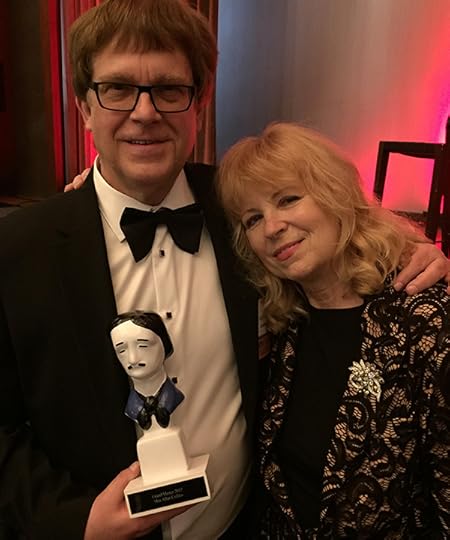
So I forgot some people (Otto I remembered). Who, you ask? How about the MWA itself, and the organizer of the event (and heart and soul of the organization), Margery Flax. I did give Barb a nice shout-out, and my agent Dominick Abel, but I forgot Brash Books altogether, though they had generously bought an ad in the program book and provided free copies to attendees of the uncut Road to Perdition prose novel.
I did manage to talk about the three key mentors of my early professional career – two of whom were MWA Grand Masters themselves, Donald E. Westlake and Mickey Spillane. I mentioned that Don had given his blessing when Bait Money sold, and generated sequels, even though they were outrageously imitative of his work. And I shared some writing advice Mickey gave me – “Take your wallet out of your back pocket before you sit down to write.” To which I said to Mickey, “Mick, I’m pretty sure your wallet is fatter than mine.”
Mostly I talked about Richard Yates, the great mainstream writer. I’ll share with you the story I told at the Edgars, with a few extra touches, since Otto isn’t handy to berate me.
As I began trying to write fiction, I was well-aware of the Writers Workshop in Iowa City, just 35 miles from my house, and I always assumed I’d go there. Never thought I’d have to do anything but just enroll. The Workshop was (and is) a graduate program, but they had a single undergraduate section of about a dozen junior and senior students. In August 1968, two months or so after Barb and I got married, I was due to start at the U of Iowa as a junior (after two years at Muscatine Community College) and thought I better go up there and submit my manuscript, as I’d learned was required.
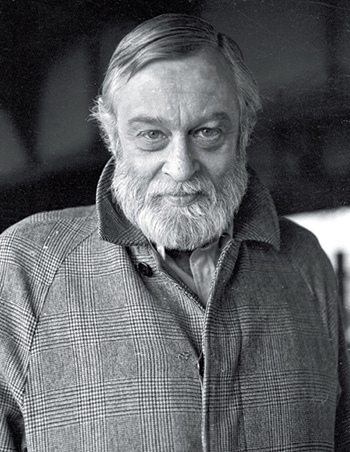
Richard Yates
Richard Yates was the instructor. I found him in his office where he was straightening things in preparation for the coming semester. A lot of skinny little manuscripts were arrayed on his desk. Short stories. Amateurs! Me, I had a novel tucked under my arm (MOURN THE LIVING).
Yates had a full-face beard and looked like a benevolent version of John Brown, the abolitionist. His eyes were always a little sad and that first day was no exception. I began enthusiastically talking about how I’d been writing mystery and suspense stories, including four novels, since junior high – that my heroes were Dashiell Hammett, Raymond Chandler and James M. Cain…I left out Spillane, knowing he was frowned upon. When I stopped bubbling over like a shaken bottle of pop, Yates took the novel from my hands and regard me with pity.
“I will take a look at this,” he said, “but I hold out no false hope to you. This kind of thing is not what we do here. We are serious writers at the Workshop, writing serious fiction.”
I went home with my tail tucked between my legs, my very dejection a cliche, my world shattered.
A few days later the phone rang. Barb, who’d endured my bleak self-pitying jag, answered, then looked at me with surprise, covering the mouthpiece, and said, “It’s that Richard Yates….”
I took the phone, wondering what abuse waited.
“Mr. Collins,” he said, “I owe you an apology. I’ve read your novel. You’re very serious about what you do, and you’re writing at a professional level above anything else that’s been submitted to me. I would be very pleased to have you in my class.”
Then, after a long pause filled by my stuttering non-response, he said, “You know, my wife and I watch Carol Burnett every week, and we laugh and laugh, and have such a good time. And I was reminded of your novel.”
I could just see the blurb – “In the Tradition of Hammett, Chandler and Carol Burnett!”
“And it occurred to me,” he said, “that there’s no shame in creating entertainment.”
Thereafter Dick Yates was my champion, even in the instances when he wasn’t my instructor, throughout the rest of my years at the Workshop. He worked with me at his home, had Barb and me over for dinner, and he landed me my first agent (Knox Burger).
First ironic postscript: I had to submit all over again to get into the graduate Workshop. But when I went to pick up my submission at the Workshop office, I was told I’d been declined, and the manuscript of Bait Money was handed back to me. By a quirk of fate, my evaluation was accidentally left in the manuscript, showing I’d been rejected by a grad student whose job was to thin the pile. And I was rejected for the same reasons that Yates had once given me before he read my manuscript.
“If the applicant wants to write this kind of thing,” the grad student wrote, “he doesn’t need to go to the Workshop to do it.”
I took this immediately to Yates – Bait Money had been written under his guidance and supervision – and he went to the top guy at the Workshop. The book was given to three instructors (not grad students) and received the highest rating possible. I was in.
Second ironic postscript: my graphic novel Road to Perdition into a film directed by Sam Mendes. Yates’ great novel Revolutionary Road was made into a film directed by Sam Mendes. Of course, Richard Yates didn’t live to see either.
We lose people along the way. My producing partner Ken Levin lost his wife Mary recently. My friend Ed Keenan, who Matt Clemens, Ed’s wife Steph and I so often played poker with, died while I was in NYC. At the Edgars, I sat watching an “in memoriam” video, and got blindsided by the smiling faces of Ed Gorman and Miguel Ferrer.
That’s why I write these pieces from time to time. To remind myself, and share with you, some of these wonderful people, who stay with us long after they’re gone.
* * *
A nice if brief write-up about the Edgars event, with pics not seen elsewhere, is here.
And a nice write-up about the night can be seen here.
Here’s a nice Executive Order review.
Here’s one for Murder Never Knocks, just out in paper.
Check out this review of the new Hammer, The Will to Kill.
And you can get a signed copy of Will to Kill here (and even see a pic of me signing it) from Otto Penzler’s Mysterious Bookshop. The description says it’s a collection (and they do have copies of Long Time Dead that I signed as well), but Will to Kill is a novel.
M.A.C.
April 25, 2017
Antiques Frame Just Published

Hardcover:




E-Book:





MP3 CD:




This week Antiques Frame, the latest “Trash ‘n’ Treasures” mystery by Barb and me (writing as Barbara Allan), goes on sale. There’s also an audio book, which we’ve sampled but haven’t listened to all the way through, though the narrator this time is much more to our liking.
I realize that certain of my readers may not be inclined to pick up a “cozy” mystery, but some reviewers have realized that the series is in part a tongue-in-cheek send-up of that genre, and also that the novels have a certain edge, even if they aren’t Mike Hammer or Nate Heller or Quarry.
This particular novel has special meaning for me – not because it’s my favorite in the series (that might be Antiques Fate, just out in mass market paperback) but because it represented a real breakthrough for me. Antiques Frame was the first book I (co-)wrote after my open-heart surgery and the stroke I had, just for fun, on the operating table. As regular readers here may recall, I woke up in the hospital to a right arm and, to some degree, right side that were as useful as a broken hinge.
At the hospital I had both physical therapy and occupational therapy, and was helped by a number of terrific people in those disciplines. My right side came back within days – I was walking well and able to do the exercises asked of me, from riding stationery bikes to going up and down stairs. But my right hand remained feeble. The idea of typing with it again seemed abstract. The most disheartening thing was that I had lost my signature.
The doctors and therapists assured me I would get my right hand back, and the doctors especially implied the use would just back on its own. Not true. I had to work hard at it, with exercises ranging from rubber band contraptions to just flat out trying to write my name over and over again.
For a writer, the loss of his or her signature is a blow to the ego, to the very idea of identity. I was determined to get it back. But my biggest fear was losing the ability to type with both hands. Fortunately, almost immediately, I had some ability to use the hand – weak as hell, though. At home I soon found that a computer keyboard is sensitive enough that very faint pressure is all that’s required. My typing style is two-fisted, having trained on (and for a long time using) manual typewriters.
So my left hand was typically strong and my right weak as a kitten. This required backing off on my left. I began writing e-mails and this weekly blog. Very soon I was able to type passably well, and the first project I tackled – still spending time with physical and occupational therapy, for several weeks here at home before going to a facility – was my draft of Antiques Frame.
Again, if you’re a regular visitor here you may know how Barb and I operate on these books. We come up with a title and a basic plot, and sometimes plot the books together and sometimes our plotting session has been good enough that Barb can break down the chapters in an outline of sorts herself. She also does character lists and time lines. The book had been plotted, roughly, before my hospital stay.
She writes a rough draft, usually 200 to 250 pages. I then write my draft of 300 to 325 pages, mostly adding jokes and polishing, plus expanding dialogue. This time she wrote a good deal of her draft in my hospital room on a laptop. As the books are humorous mysteries, I’m not sure how she managed that.
When I began working on the book, I discovered that she had (not surprisingly) done a fine job, but (somewhat surprisingly) the humor quotient was typically high. In my diminished state, I hoped I could keep the thing funny, too. Frankly, I was hoping it would just be in English. But the effort went well, and working on a “Barbara Allan” was the perfect way for me to get back up on the writing horse and write/ride.
My right hand came back within a couple of months, pretty much strong as ever. And several more months later, when the galley proofs arrived of Antiques Frame, I swallowed hard and sat down to read them. I was amazed to find out the book was not only in English, but a solid and very funny entry in the series. It’s a reminder that writers live chiefly in their heads – their physical state is something they have to deal with, obviously, but as long as the mental engine is firing on all cylinders, the rest is incidental.
The other thing I learned is how good my wife has gotten at writing, and how generally wonderful a woman she is – actually, I already knew, but the experience of taking my pass on Antiques Frame was sweet confirmation.
* * *
Barb and I are preparing for our NYC trip for the Edgar awards and my receiving the Grand Master award. That’s on Thursday evening. For those of you in the New York area, here’s the line-up for the Wednesday Edgar-week symposium, which includes Charles Ardai of Hard Case Crime interviewing me.
Symposium Schedule
Cost: $95 members; $125 non-members – with a $15 retroactive discount for those who join MWA within 30 days after.
8:30 – 8:50: Registration
8:55 – 9:00: Welcome – MWA’s Executive Vice President – Donna Andrews
9:00 – 9:50: Meet the Class of 2017 – Best First Novel Nominees
Moderator: STEFANIE PINTOFF, 2010 Best First Edgar Winner (City on Edge, Bantam)
Panelists: Flynn Berry (2017 Best First Edgar Nominee – Under the Harrow, Penguin Books)
Bill Beverly (2017 Best First Edgar Nominee – Dodgers, Crown Publishing)
Joe Ide (2017 Best First Edgar Nominee – IQ, Little, Brown & Co – Mulholland Books)
Nick Petrie (2017 Best First Edgar Nominee – The Drifter – G.P. Putnam’s Sons)
Lili Wright (2017 Best First Edgar Nominee – Dancing with the Tiger – Marian Wood/Putnam)
Heather Young (2017 Best First Edgar Nominee – The Lost Girls – William Morrow)
10:00 – 10:50: From the Writer’s Desk, Part 1
Grand Master Max Allan Collins interviewed by Charles Ardai
11:00 – 11:50: Just the Facts – If you’re not writing what you know, you’re writing what you want to know – and today’s savvy reader will send you a note if you get it wrong, How do writers of fiction and nonfiction crime approach research? When do they know they’ve researched enough?
Moderator: LAURIE R. KING, MWA NorCal Chapter President (Murder of Mary Russell – Bantam)
Panelists: Ruth Franklin (2017 Best Critical/Bio Nominee – Shirley Jackson – W.W. Norton)
Laurence Leamer (2017 Best Fact Crime Nominee – The Lynching – William Morrow)
Kate Summerscale (2017 Best Fact Crime Nominee – The Wicked Boy – Penguin Press)
Caroline (Charles) Todd (2017 MHC Award Nominee – The Shattered Tree – William Morrow)
James Ziskin (2017 Best PBO Nominee – Heart of Stone – Seventh Street Books)
11:50 – 1:00 Lunch Break (On Your Own)
1:00 – 1:50: Nursery Noir – Writers of mysteries for young readers may have the toughest audience of all. How do dark stories translate for the teen and tween set? How do adult writers get into the minds – and hearts – of kid readers?
Moderator: LORI RADER-DAY, MWA Midwest Chapter President (The Day I Died – William Morrow)
Panelists: Brent Hartinger (2017 Best Young Adult Nominee – Three Truths and a Lie – Simon Pulse)
April Henry (2017 Best Young Adult Nominee – The Girl I Used to Be – Christy Ottaviano Books)
Sarah Lariviere (2017 Best Juvenile Nominee – The Bad Kid – Simon & Schuster BFYR)
James Ponti (2017 Best Juvenile Nominee – Framed! – Aladdin)
Billy Taylor (2017 Best Young Adult Nominee – Thieving Weasels – Penguin YR – Dial Books)
Susan Vaught (2017 Best Juvenile Nominee – Things Too Huge to Fix by Saying Sorry – Paula Wiseman Books)
2:00 – 2:50 Liars Club – Liars, cheats, thieves, murderers – and, sometimes, those are the protagonists. How do writers create characters that keep readers up at night? How do they create empathy in characters who make bad guys look pretty good?
Moderator: JEFFERY DEAVER, 2017 MWA President (The Burial Hour – Grand Central Publishing)
Panelists: Laura Benedict (2017 Best Short Story Nominee – “A Paler Shade of Death” – St. Louis Noir)
Alafair Burke (2017 Best Novel Nominee – The Ex – HarperCollins)
Robert Dugoni (2017 Best PBO Nominee – The 7th Canon – Thomas & Mercer)
Lyndsay Faye (2017 Best Novel Nominee – Jane Steele – G.P. Putnam’s Sons)
Alison Gaylin (2017 Best Novel Nominee – What Remains of Me – William Morrow)
Martha Hillier (2017 Best TV Episode Nominee – “Dark Road” – Vera)
3:00 – 3:50: #AuthorLife – There’s no one way to be a crime writer. Agent/no agent. Small press/big five. Plotter/pantser forever. How did these authors get into the life of crime – and what advice do they have for aspiring writers taking a stab at mystery?
Moderator: MARK STEVENS, MWA Rocky Mtn Chapter President (Lake of Fire – Midnight Ink)
Panelists: Megan Abbott (2017 Best Short Story Nominee – “Oxford Girl” – Mississippi Noir)
Patricia Abbott (2017 Best PBO Nominee – Shot in Detroit – Polis Books)
Reed Farrel Coleman (2017 Best Novel Nominee – Where it Hurts – G.P. Putnam’s Sons)
Tyler Dilts (2017 Best PBO Nominee – Come Twilight – Thomas & Mercer)
Adrian McKinty (2017 Best PBO Nominee – Rain Dogs – Seventh Street Books)
Wendy Corsi Staub (2017 MHC Award Nominee – Blue Moon – William Morrow)
4:00 – 4:50: From the Writer’s Desk, Part 2
Grand Master Ellen Hart – Interviewed by Oline Cogdill
* * *
All the books have been mailed out on our “free books” offer. Just about everyone who requested one got one.
The newly published Executive Order has received some nice notices, like this one.
And another one here.
This article includes me as a mystery writer doing some TV scripting.
Finally, and I kid you not (as Jack Paar used to say), here’s a review of the 1985 trade paperback, The Files of Ms. Tree Vol. 1.
M.A.C.
April 18, 2017
The Big Time
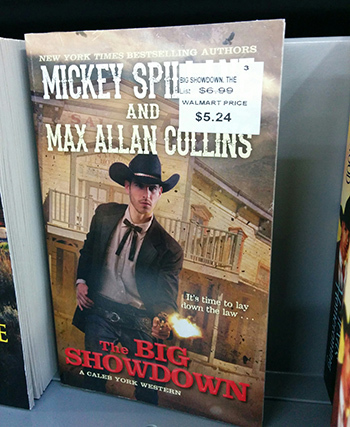
The picture was taken at the Muscatine, Iowa, Wal-Mart, showing the paperback edition of The Big Showdown for sale on its shelves. This, my friends, is truly the big time. I haven’t spotted a book of mine here since the heyday of the CSI tie-ins.
I’d had reports of sightings of The Legend of Caleb York at Wal-Marts here and there around the USA, but it didn’t make it to my hometown, where the book area is fairly modest. Romances make up the biggest number of titles, but westerns are also a staple. Mysteries/thrillers of mine don’t make the cut.
While the new Mike Hammer novels, and the several non-Hammer Hard Case Crime posthumous Spillane titles, have all done modestly well, the success of Spillane as a western byline might just have more impact. And Wal-Mart is a big part of that, because they are one of the few book outlets that support Westerns, big time.
And the Spillane byline has real resonance with the older audience that buys Westerns. Not all Western readers are Baby Boomers like me, who recognize the name of the bestselling fiction writer of the 20th Century. But a good share are. Mickey’s friend Louis L’Amour, who died in 1988, is still one of the top names in the Western field.
Mickey, of course, viewed Mike Hammer as a Western-style hero moved to the urban frontier. He often said that Hammer “wore the black hat,” but was a good guy nonetheless.
Though I’ve been a fan of Western movies and TV since childhood – what Baby Boomer male wasn’t? – I never considered writing a Western novel. I’ve only read a handful in my life. But one of my earliest obsessions was the Maverick TV show, and a good deal of Bret Maverick got into Nate Heller. And I watched all those shows – Bat Masterson, The Life and Legend of Wyatt Earp, Gunsmoke (when it was thirty minutes), Yancy Derringer and so many more.
And some of my favorite films are westerns – The Searchers, Ride the High Country, Rio Bravo, Red River, The Tall T, Comanche Station, Ride Lonesome, Seven Men from Now, and The Good, the Bad, and the Ugly. My character Nolan drew from the Italian westerns of Lee Van Cleef – The Big Gundown, Death Rides a Horse, For a Few Dollars More.
So maybe it was inevitable that, before I rode off into the sunset, I’d be writing some Westerns. I had already written the novelization of the movie version of Maverick and the Wyatt Earp Meets Al Capone novel, Black Hats (new edition coming from Brash Books).
Plus the unproduced screenplay of Mickey’s that started it all, The Saga of Calli York, was written for his pal John Wayne. (“Calli” a now inappropriate nickname for “Caleb,” the former dropped from the books.) You’ll note quite a few Wayne titles among those listed above. I had only intended to write the one book, novelizing that screenplay, but my editor at Kensington Books insisted on three novels. And now I’ve signed to do two more.
This marks the first time Mickey’s byline appears with mine on books to which he didn’t contribute any writing. But the Caleb York yarns use his characters and situations and are a legitimate extension of the vision he developed in the screenplay – a winning combination of the Western myth of those John Wayne and Randolph Scott westerns and a more violent, pre-Leone approach.
The sex is there, too, but somewhat soft-pedaled. Apparently Wal-Mart will go for the tough stuff, but nothing smutty. Maybe that’s why Nate Heller never made it on their shelves….
* * *
I had a fun e-mail from my old pal Steve Noah that I’d like to share with you.
“Max,
Am in Kigali, Rwanda at 1:20 AM finishing EXECUTIVE ORDER and thought you might be interested to know that the clever lighting of the Washington Monument you mention on page 233 was provided by Musco Sports Lighting, with ties to Muscatine.
Best,
Steve”
My thanks to Steve for this fascinating info.
Musco is a very famous lighting company, much used in big-time sports and by Hollywood. The “Musc,” as you may have figured out, stands for Muscatine, the river town of 23,000 where Barb and I have always lived.
The Musco operation is adjacent to the junk yard where the climax of my movie Mommy was shot in 1994. They provided the lighting. I often joke that they just turned their lighting trucks around and pointed them our way, but really they did much more than that.
I’m honored that this incredibly famous company supported my small filmmaking endeavor.
* * *
Wild Dog is a regular on Arrow, now. Still haven’t seen any episodes. I’ll watch when I receive a check.
M.A.C.
April 11, 2017
Hey, Kids! Free Books…Again!
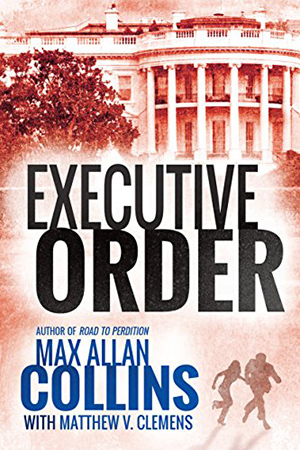
Paperback:




E-Book:

Audio MP3 CD:




Once more, we are going to offer copies of our work – and I’m talking in the editorial “we” to some extent, but also about Barb and me – to the first responders (and not just cops and fireman) among readers who agree to post an Amazon review. Barnes & Noble works, too, and if you have your own blog, that’s great also. But Amazon seems to be where sales get an impact.
As has happened to me too many times to mention, I have a bunch of books coming out more or less at once. So here’s what’s on offer…
The Will to Kill by Mickey Spillane and You Know Who. The new Mike Hammer that I wrote working from Spillane material, and something of a change of pace, with an Agatha Christie-type set-up complete with greedy offsprings in a big remote house.
Antiques Frame by Barbara Allan. Brandy goes to jail accused of murdering the wife of the man she’s been dating for much of the series, and Mother must investigate, including contemplating attracting attention by going “the partial Vivian” (as opposed to the Full Monty). These are funny novels and if they don’t make you laugh, you’re dead from the neck up. Available are a mix of trade paperback advance copies and a few hardcovers.
Antiques Fate by Barbara Allan. This is the paperback reprint of last year’s hardcover. Brandi and her mother go to an English-style village where Vivian will do her one-woman show of “the Scottish play,” and murder most foul will ensue.
The Big Showdown by Mickey Spillane and me. The second Caleb York western, now in paperback. The crazy brothers of somebody Caleb killed in the first book are on the warpath, and they aren’t even Indians. There’s also a mystery growing out of the murder of a recurring character. (Well, not recurring anymore….)
Executive Order by M.A.C. and Matthew V. Clemens. The conclusion to the “Branches of Government” trilogy of political thrillers which are almost as bat-shit crazy as the real world. Have you met Reeder and Rogers yet? If you haven’t tried one of these, what are you waiting for?
Five copies of each are available. Write me at macphilms@hotmail.com and list, in order of preference, the books that interest you. You’ll only get one of the titles. If there’s something you already have or aren’t keen on getting, don’t list it.
IMPORTANT: include in your e-mail your snail-mail address. You’ll likely be skipped over if you don’t. Also, this is only for the USA. Canadians must buy the books to read them. Don’t feel bad – Trump isn’t your president.
Okay? Got the rules?
These go fast, but it usually takes at least a few days, so don’t give up without trying.
And if you’re already a paying customer for any of these, picture me on my knees begging: write Amazon reviews of the books of mine/ours you’ve read lately. Post those reviews on your blogs and Facebook pages, but make sure to do so at Amazon. Will to Kill, a novel people really seem to like, is very under-reviewed. Quarry in the Black could also use some love, and the same goes for Better Dead.
Grass roots attention is important. The trades (Publisher’s Weekly, Booklist, Library Journal, Kirkus) are reviewing less and less of my material, apparently because when a series runs a while, they just don’t bother. Or maybe they just think I write too much. Even Mystery Scene and Ellery Queen are spotty – the last Queen review just lumped a bunch of my books together.
This doesn’t go for just me – any writer you like, any writer you follow, will benefit (and stay in business) by you writing an Amazon review and/or a Blog entry. A good place to start? My stuff.
Thank you.
Speaking of reviews, here’s a nifty one of The Will to Kill.
Here’s a piece wondering if there will be a second season of Quarry, wishing there would be. From your lips to Cinemax’s ear.
Some coverage of the Stacy Keach Mike Hammer audios can be found here.
And Ms. Tree gets some love here, including a podcast (that I haven’t heard yet).
M.A.C.
April 4, 2017
A Showdown and a Ghost
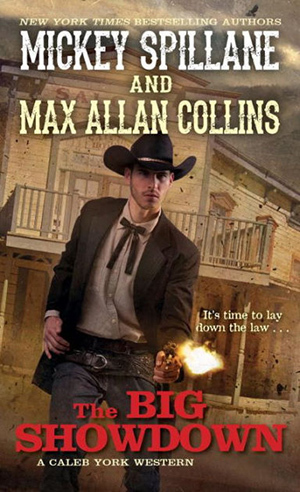




The mass-market edition of The Big Showdown, the sequel to The Legend of Caleb York, has just come out. It continues with the characters and stories that Mickey Spillane developed in the (unproduced) screenplay he wrote for his friend John Wayne in the late 1950s.
Response to this new series, representing my first westerns (unless you count the movie novelization Maverick and maybe my Wyatt Earp meets Al Capone novel, Black Hats), has been positive. In fact, I’ve completed a third Caleb York story, The Bloody Spur, and have signed to do two more.
The novels are in part mysteries, befitting the two bylines, and are otherwise very old-fashioned westerns in the manner of Randolph Scott and Audie Murphy movies of the fifties and early sixties…but with a higher, more Leone-like level of violence, which is only appropriate with the name Spillane invoked. Mickey’s York screenplay was far more violent than anyone in the western film or novel field was doing at the time. The sexual content was adult for its time, but that time has passed.
The book was one of the last that I completed before I went in for my heart surgery – one of a handful on my docket that I wanted to make sure got done in case…well, you know. I thought it came out well and am particularly proud of the finale, a shoot-out – you might say, a big showdown – in a rainstorm…also typically Spillane.
If you like my crime novels but don’t usually read westerns, give these a try anyway. I’m pretty sure you’ll like them.
* * *
The movie Ghost in the Shell, based on a famous Japanese animated film (which spawned an anime series and many sequels) has been getting a rough time of it. Only 43% fresh on Rotten Tomatoes, it received a scathing review on Facebook by my pal, Terry Beatty, with whom I rarely disagree on films. He hated it so much that I’d decided not to go, though based on the previews I’d been looking forward to it.
But the workload right now is so brutal, I needed a break, and took a risk. I’d read the positive reviews among the pans and caught hints that I might not agree with Terry. And I didn’t.
Barb and I are becoming infamous for walking out of movies, and we fully expected this to be one of them. Instead we both loved it. Scarlett Johansson is Major, whose human brain has been inserted in a robot body, designed to be the perfect terrorist fighter. She inhabits a world futuristically Asian, influenced by Blade Runner’s city but even more complex in its imagery.
Johansson is very good, much as she was in Lucy, moving with a certain robotic gait though not overstating it, her dialogue delivered in a similar fashion. She has a team of cyber-enhanced soldiers, one of whom is her partner, played by “Pilou” Asbæk, the Swedish actor who was so good in the TV series Borgen, the nordic West Wing. Major is having flashes of memory and humanity that are intruding on her search for an uber-terrorist, but of course everything is not as it seems.
A special treat is the presence of Takeshi Kitano, director/writer/star of Violent Cop and Boiling Point, among other great Japanese crime films. He’s essentially M to Major’s Jane Bond, but he gets out from behind the desk and kicks ass, late in the proceedings.
Themes of identity, family and loyalty are explored, but not to the detriment of well-staged action scenes that don’t indulge in that speeded-up crap. The art direction is stunning throughout, and seldom has CGI been better employed. We saw it in 3-D, which really enhanced the levels of the design work.
I have hesitated till recently to review movies again. I know how hard it is to make one. And I realize that taste is individual, and smart people can disagree. If you skip a movie because I don’t like it, you may be making a mistake. And if you go to one because I did like it, you might also be making a mistake.
But I don’t think so.
* * *
This review of The Big Showdown first appeared last year about this time, but if you’re considering picking up the paperback, you might want to check this out.
M.A.C.



